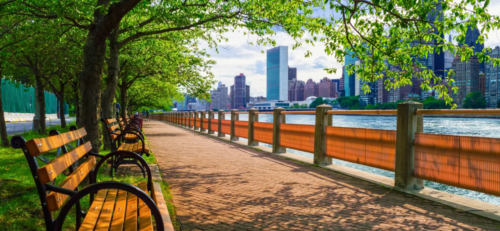
Op-Ed | NYC’s parks are in crisis; Mayor Adams can make it right
By Adam Ganser and Julie Tighe
March 19, 2024
Our Parks Department’s staffing levels have experienced a five-year decline, with this year being the lowest second only to drastic cuts in FY21, at the pandemic’s onset. The $25 million budget cuts announced in November inexplicably targeted the historically strapped agency, slashing its budget by 5% and eliminating key programs aimed at swim safety, maintenance of our city’s natural areas and crime reduction.
Now, the Mayor’s preliminary budget for the next fiscal year proposes an additional $55 million reduction in funding and a resulting headcount that is at historic lows. A decrease of this magnitude is a devastating blow for an agency struggling to survive on a minuscule budget due to decades of underinvestment. These cuts run deeper against the backdrop of Mayor Adams’ unfulfilled promises, having vowed to dedicate 1% of the City’s budget to the Parks Department on multiple occasions.
On paper, New York City boasts an enviable parks system. Amongst the skyscrapers and bustling streets are 1,942 parks, over 1,000 playgrounds, 800 athletic fields, 550 tennis courts, 60 public pools, 30 recreation centers, 14 miles of beaches, acres of natural areas and other community assets spread across five boroughs – all managed by our Parks Department.
However, reality tells a bleaker story. The agency is funded and managed with the same strategies it employed when the city neared bankruptcy in the 1970s. During this time, funding for parks was drastically reduced and never fully recovered. Before the economic downturn, the City would allocate 1.4% of its budget to Parks funding, supporting a workforce of 11,000 employees to effectively operate and maintain its robust green infrastructure, engage with communities and keep parks safe.
Fifty years later, the Parks Department receives only 0.5% of the City’s budget, with staff levels creeping towards 7,000. Major cities like Chicago, Minneapolis and Los Angeles also faced similar financial crises, but unlike New York, their parks systems have rebounded. Why? Because these cities recognized parks as essential civic assets that address issues of equity, public health, climate mitigation and economic development. These cities allocate between 2.9% and 5.3% of their respective budgets to parks funding – which translates to more spending per capita and per acre when compared to New York City, and exemplifies the stark contrast to the austerity mindset plaguing our Parks Department.
This is fundamentally an equity issue. For far too long, New York’s low-income communities, disproportionately represented by racial and ethnic minority groups, have borne the brunt of the City’s neglect. While a handful of communities have benefited greatly from conservancies that fund, support and care for specific parks, these few organizations do not represent a scalable model for the city’s 1,700+ parks. Nor should they. Without appropriate City investment, it’s the parks, pools and recreation centers in lower-income neighborhoods that are most harmed. This is unacceptable when New Yorkers are coming to our City’s parks and open spaces in droves.
Our Parks system is in crisis. Public funding for public spaces is not a luxury but a necessity – an investment in the health, happiness, and prosperity of our city. Without it, communities will continue to grapple with unsafe spaces, unmaintained greenery, deteriorating infrastructure, and unsanitary and even hazardous conditions.
Adequately funding our city’s parks system is entirely feasible, and well within the Mayor’s power to address. While Mayor Adams holds the Parks system hostage by tying its funding to the asylum seeker crisis, we can’t lose sight of the small financial scale here. Parks funding is dwarfed by other major city agencies, and represents a tiny fraction of the city’s overall budget – currently proposed to be just $583 million out of a total $110 billion – essentially lint in the administration’s pocket.
While the sector celebrates the invaluable contributions of tens of thousands of volunteers working tirelessly to maintain their parks, and investigates alternative funding avenues, we can’t take our eyes off the ball. Only public funding can fix this problem, and we’ll continue to pressure the administration to deliver this investment. The Mayor can start by fulfilling the Play Fair for Parks coalition’s demand for 1,000 additional Parks workers in order to restore agency staffing levels to pre-COVID levels.
With the Parks Preliminary Budget Hearing approaching, New Yorkers can play a critical role in calling on the administration to meaningfully fund our parks by signing the 1% for Parks petition, spearheaded by NYC Parks advocates.
It’s time to disrupt this dangerous cycle of underfunding and commit to building a brighter, greener and equitable future for all New Yorkers.
Adam Ganser is Executive Director of New Yorkers for Parks. Julie Tighe is President of the New York League of Conservation Voters.